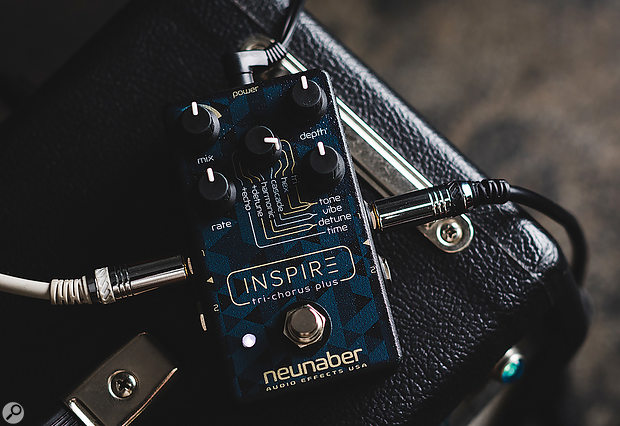Anybody who is old enough to remember the popular music of the 1980s will recall an era of big‑haired performers and recordings featuring even bigger chorus sounds — bands including the Police, Rush, Heart, and countless others drenched their recordings in luxuriant and thick chorus textures.
The great breakthrough in choruses that led to these ubiquitous tones was the tri‑chorus — an effect that blends three choruses together to create the impression of there being no ‘central’ chorus frequency. With a regular chorus, you can hear the LFO clearly as it rolls through its cycles. Not so with a tri‑chorus, which sounds more like a texture of chorus sounds. In the ’80s, rack units such as the Dyno My Piano were pretty much a requirement for any properly equipped recording studio. Tri‑choruses have experienced a resurgence over the last several years, with a number of pedals and a few reissues of rack units being brought to market. The Inspire Tri‑chorus Plus pedal reviewed here is a recently released product by the boutique manufacturers Neunaber, who are based in Orange, California.
The Inspire is a compact pedal capable of producing an impressive range of tri‑chorus sounds. Unlike most other pedals, the Inspire produces solely tri‑chorus voices — it’s not possible to turn off any of the individual chorus voices. But that’s not a huge limitation because the Inspire really revels in those tri‑chorus sounds, offering eight core settings with adjustable Mix, Depth and Rate, along with a fourth knob whose function varies according to the other settings.
The Inspire offers studio‑quality stereo sound, with a low noise floor of ‑106dB. While it’s clearly intended for a guitar or keyboard player to include on a pedalboard, it could just as easily serve as a processor for a mixing board or digital recording setup. It works perfectly well with the ubiquitous standard 9V centre‑negative PSU, but it is also happy operating with higher voltages — indeed, the manufacturers recommend using 12V in a recording environment, where you are using pro (+4dBu) line‑level inputs. The benefit of the higher voltage is greater headroom for the pedal, which translates to it tolerating higher input levels. I tested the Inspire with a number of electric guitars and a Yamaha synth module. I noticed no differences in the quality of sound, noise, or volume levels.
Offering any kind of in‑depth control over the many parameters available within the Inspire would defeat the purpose of a small pedalboard‑friendly stompbox. So what Neunaber have done is to make behind‑the‑scenes changes to the controls for each primary setting, and then present the user with four knobs for further tweaking. This is really the Inspire’s ‘secret sauce’, because the total interaction of sounds and controls is really quite complex.
There are eight primary settings. Setting one, Traditional, is a regular tri‑chorus, and knob four controls chorus tone. Setting two, called Hex, runs two tri‑choruses in parallel, with knob four controlling the chorus tone. Setting three, Cascade Tone, links two tri‑choruses in series, and knob four controls the chorus tone. Setting four, Cascade Vibe, is a tri‑chorus with a variable vibrato, and knob four controls vibrato rate. Setting five, Harmonic Vibe, is a low‑frequency tri‑chorus with a high‑frequency tri‑vibrato. Knob four controls vibrato rate. Setting six, Harmonic Detune, is a low‑frequency detune with a high‑frequency tri‑chorus. Knob four controls pitch offset. Setting seven, +Detune, is a tri‑chorus with detune, for which knob four controls pitch offset. And finally, setting eight, +Echo, is a tri‑chorus with stereo echo. Knob four controls echo time.
The sounds this pedal produces are wonderfully rich and complex — the tri‑choruses sound like cloudy swirls of audio candy flosscotton candy! I was also pleased to discover that the Inspire is capable of venturing out of regular tri‑chorus boundaries into variable vibrato and modulation sounds; there’s even a reasonably convincing rotary speaker simulation. The echo sound is more of a tri‑chorus‑echo blend, with a subtle echo that you wouldn’t use as a stand‑alone echo effect. I did notice a slight decrease in dynamics when the pedal is engaged, though, so, especially for solo work, you might need to boost the signal level slightly.
With the great range of sounds this pedal can produce, it’s a shame that there’s no way to preserve or modulate the settings other than by hand. I would have loved to see any combination of presets, MIDI control, or a modulation pedal jack. Instead, what you have set on the knobs at any given time is what you will hear when the pedal is engaged.
The Inspire tri‑chorus is a phenomenal‑sounding pedal in a very compact package. It boasts great sound and noise specifications with stereo I/O. In the context of the tri‑chorus universe, it features a large palette of tones, settings and sounds. To achieve these features in such a compact pedal, the manufacturer chose to limit additional controls via presets, MIDI or a modulation pedal. Still, as a special‑purpose pedal to get authentic and ‘inspiring’ tri‑chorus sounds, it is one of the most compelling options currently available.
£229 including VAT.
$259.

